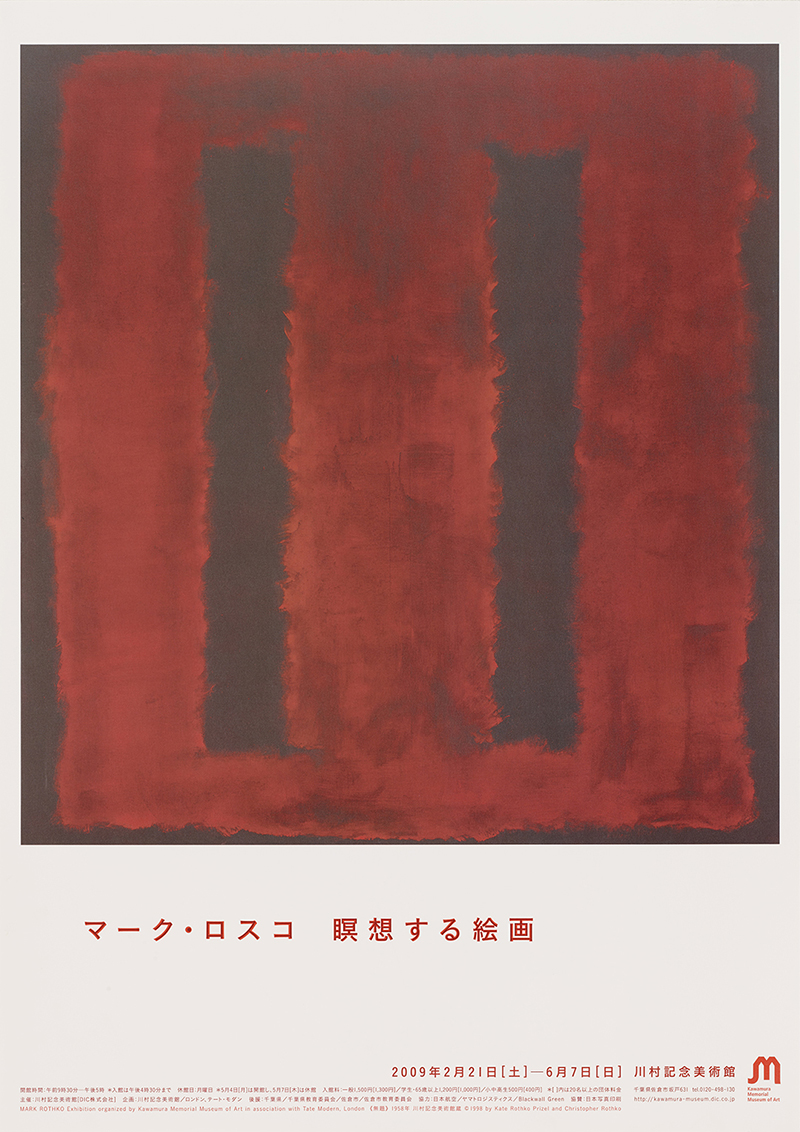Outline
Mark Rothko was born in Dvinsk, Russia (current Daugavpils, Republic of Latvia) in 1903. During his childhood he immigrated to the United States with his family. Although he entered the prestigious Yale University, he left after two years. In 1923, he moved to New York to become a painter. In the beginning, his motifs were painted in gloomy tones and included indoor figures and cityscapes such as subway stations. Then, he moved on to a surrealistic style of painting with titles based on ancient mythologies. After the mid 1940s, he departed from representational painting and, finally, he arrived at a style with amorphous cloud like shapes floating on large surfaces. These paintings, which were abstract, yet mysterious and lyrical with colored surfaces producing light, immediately gained attention and Rothko became one of the most popular painters representing the United States.
While receiving fame, Rothko began to dream of having his "own space for paintings." This would be a room with only his paintings, without those of other painters, in which he would control the lighting and install as he desired. In doing this, for the first time, Rothko’s paintings become alive and his multiple artworks are able to respond to each other like music as viewers are completely surrounded.
"Seagram Murals" is a series of artworks in this exhibition that Rothko undertook after being given a space for the first time. However, because the specified space was a private dining room in the high-class restaurant, "The Four Seasons," in the Seagram Building in New York, where every night, well-dressed celebrities came to enjoy conversation and luxurious meals, Rothko rejected the pretentious atmosphere and decided to turn down the deal that he had previously accepted happily. As a result, when his 30 paintings were completed, he lost their exhibition opportunity.
The "Seagram Murals" series differs from his previous artworks. On the wall, they appear to form a large horizontal surface, with forms reminiscent of window frames arranged and painted in maroon, orange and black as their base colors. These paintings transport viewers to a deeper, unknown world. Surrounded by an overpowering existence resembling an ancient ruin, one reflects upon and explores one’s mind and meditates--- Rothko must have longed to realize such a space. Finally in 1970, nine of the "Seagram Murals" traveled across the Atlantic to find a home at the Tate Gallery in London. An additional seven of them have been exhibited in one room at Kawamura Memorial DIC Museum of Art since the museum’s opening in 1990. As the sole Rothko room in Asia, it has been highly popular for many of our visitors.
For this exhibition, fifteen paintings, half of "Seagram Murals," which have been scattered for more than 50 years, are gathered together for the first time to create a new Rothko space. This exhibition is a rare opportunity unlikely to occur again. Also part of the exhibition, models and sketches related to "Seagram Murals" and large paintings completed before and after "Seagram Murals" including a series rarely seen, as well as Rothko’s letters, which are exhibited for the first time to the Japanese public, will each present the essence of Rothko’s later years.
Programs
Cross Talk (in Japanese)
Kenichiro Mogi (Neuroscientist) × Sumi Hayashi (Curator, Kawamura Memorial DIC Museum of Art)
In the exhibition space surrounded by the red "Seagram Murals," two professionals from different fields will discuss the appeal of Rothko’s paintings.
March 29, 17:30-19:00
Participation Fee: 1000yen (admission fee not included)
First 100 persons only. Participation tickets will be available for purchase at the museum entrance on the day of the event from 13:00.
*Please understand in advance that the schedule may change or be cancelled.
Gallery Talks by Curator (in Japanese)
February 21, March 14, April 10, May 24
14:00-15:00 First 40 arrivals
Guided Tours of the Entire Building by Guide Staff (in Japanese)
14:00-15:00 every day except on Lecture or Curator Gallery Talk days
First 40 arrivals
Audio Guide (in Japanese)
Included are explanations for the Rothko Exhibition, the Collection Display and chamber music by Mozart and Schubert. In consideration of Rothko’s deep appreciation for classical music, his son, Christopher Rothko has selected the music.
Rental fee: 500 yen per headse
